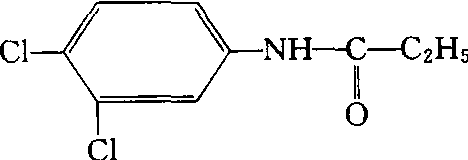敌稗propanil
茎叶处理、触杀型选择性酰胺类除草剂。商品名斯达姆。化学结构式:

性能 纯品为白色晶体,熔点92~93℃,室温下水中溶解度为225毫克/升,乙醇中溶解度为54%(25℃ );原药为浅黄色固体(含有效成分90%以上),熔点为85~89℃。难溶于水,易溶于甲醇、乙醚等有机溶剂。遇酸遇碱易分解。对高等动物低毒。纯品大鼠急性经口LD50 1400毫克/千克,家兔急性经皮LD50 为7080毫克/千克。鲤鱼LC50为13毫克/千克。具有较高选择性。这是因为水稻体内芳基羧基酰胺酶能将敌稗分解成3,4-二氯苯胺和丙酸而脱毒;稗草由于缺乏这种酶解毒功能,使细胞最先遭到破坏、失水而枯死。2叶期前稗草最为敏感。敌稗遇土壤分解失效,仅宜作茎叶处理。
应用 敌稗主要用于秧田、插秧田和直播田防治稗草。对水马齿、鸭舌草和旱田马唐、狗尾草、野苋等杂草的幼苗也有效。使用方法是: ❶当秧田稗草1叶1心(稻苗立针)时,用20%敌稗乳油11.25~ 15升/公顷,于排水后均匀喷雾,使整株稗草受药,处理后1~2天不灌水,晒田后深水淹没稗草心叶部两昼夜,可提高防效。覆膜秧田可在揭膜后2~ 3天施药。
❷插秧本田当稗草1叶1心时,选择晴朗天气,排干田水,每公顷用20%敌稗乳油15升,对水均匀喷雾。药后1~2天不上水。晒田后再灌深水(不可淹没稻苗心叶)淹稗两天。
❸以稗草为主的直播田,在稗草2叶期前,按秧田剂量和方法进行处理。可与丁草胺、禾草丹、恶草酮等混用。但是,由于氨基甲酸酯类、有机磷类杀虫剂能抑制水稻水解酶的活性,因此在施敌稗前后10天内不能使用这些农药,更不能与之混用,以免发生药害。
敌稗propanil
酰胺类选择性触杀型除草剂。化学名称:N-(3,4-二氯苯基)丙酰胺。化学结构式如下。纯品为白色针状结晶,熔点92~93℃,60℃时蒸气压为12 × 10-3 Pa,微溶于水,易溶于甲醇、乙醇、乙醚、丙酮、苯等有机溶剂中。在酸、碱性介质中易分解,在土壤中易分解失效。只在接触药剂部位起作用,破坏植物的光合作用,抑制呼吸作用与氧化磷酸化作用,干扰核酸与蛋白质的合成等,受害植物失水干枯死亡。水稻体内酰胺水解酶能迅速分解敌稗,而不受毒害。氨基甲酸酯类、有机磷类杀虫剂能抑制水稻体内酰胺水解酶的活性,而造成药害。因此,水稻施用敌稗前后10天内,不能使用这两类农药,更不能与这些农药混用。主要用于稻田防除稗草、鸭舌草、野慈姑、水马齿苋、藜、红蓼、马唐、狗尾草等。对人畜低毒,大鼠急性口服LD50为1 384±99 mg/kg,兔急性经皮LD50为7 080 mg/kg,对鱼有高毒。
